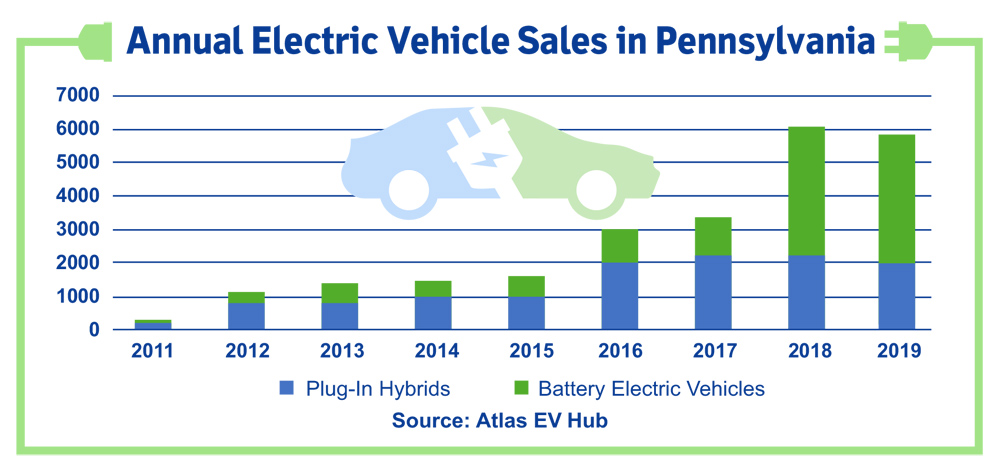
Pennsylvania regulators Thursday opened a rate design proceeding to encourage electric vehicle charging during off-peak hours.
Responding to a petition by a coalition of EV stakeholders and environmental groups, the Public Utility Commission voted unanimously to create a working group to provide the commission with recommendations by March 31, 2023 (P-2022-3030743). The commission’s directive calls for the issuance of an order responding to the recommendations by June 1, 2023.
The coalition, ChargEVC-PA, called for the proceeding in a petition filed Feb. 4, saying EV charging “will dramatically increase peak demand on the distribution system unless charging is directed to off-peak periods.”
“The significant increase in consumption due to EV charging has the potential to reduce system costs and rates for all customers because the fixed costs of the distribution system will be collected over a much larger number of kilowatt-hours,” said the group, whose members include the Electrification Coalition, Keystone Energy Alliance, Natural Resources Defense Council, Plug In America, Sierra Club and Gettysburg-based Adams Electric Cooperative.
Obstacle
The petition cited the state Department of Environmental Protection’s Electric Vehicle Roadmap, which identified as an obstacle the lack of utility rates designed to encourage EV adoption.
“Only two Pennsylvania companies offer time-varying (such as time-of-use, or TOU) rates for the supply portion of the bill (Duquesne [Light Co.] and, more recently, PECO [Energy]), and none of the electric distribution companies in Pennsylvania offers TOU rates for the delivery portion of the bill,” the group said. “Moreover, the TOU rates that Duquesne and PECO offer are for ‘whole house’ use. The roadmap recommends a strategy to advance EV deployment, where ‘each utility and electricity supplier could be encouraged to analyze and propose rate designs based on their own peak periods, timelines for introducing advanced meters, and other considerations and constraints.’”
Only 29,000 of the more than 12 million registered vehicles in Pennsylvania are electric, a penetration rate of less than 1%. But the group cited data showing global EV sales increased 41% in 2020 and projections that EVs will represent 25 to 30% of total sales by 2030 and 45 to 50% by 2035 as falling battery prices bring EVs to purchase price parity with internal combustion engine vehicles.
 Pennsylvania electric vehicle sales by year | Pennsylvania Electric Vehicle Roadmap, 2021 Update, Pa. Department of Environmental Protection
Pennsylvania electric vehicle sales by year | Pennsylvania Electric Vehicle Roadmap, 2021 Update, Pa. Department of Environmental Protection
Pennsylvania expects to receive $171 million over five years from the Infrastructure Investment and Jobs Act to help build out an EV charging network.
The five PUC commissioners approved a joint motion by Chair Gladys Brown Dutrieuille and Vice Chair Stephen DeFrank, with Commissioner Ralph Yanora issuing a supporting statement saying the resulting rates should be “cost-based” and “not include subsidies.”
Commissioner Kathryn Zerfuss also issued a statement, saying that “affordability and equity should be paramount” in any resulting rates. “Our commonwealth should be a leader — proceeding without delay — to demonstrate to the federal government that our actions are deliberate and meaningful, so that we can maximize all potential federal funding available to Pennsylvania for EV infrastructure,” she said.
Other States’ Actions
The petition by ChargEVC-PA included descriptions to rate design initiatives by regulators in Arizona, Maryland and Minnesota.
Baltimore Gas and Electric, PEPCO, and Delmarva Power and Light told Maryland regulators last year that participants in their EV rate design pilot projects had responded to TOU rates by reducing and shifting consumption, with savings of 5.3 to 9.7% in the first year and 2.3 to 7.5% in the second year. The pilots also reduced peak demand in the summer season by 9.3 to 13.7% and by 4.9 to 5.4% for the non-summer season, the utilities reported.
In January, the Maryland Public Service Commission approved changes to the state’s pilot programs (Case No. 9478; Order No. 90036). “With two years remaining in the pilot, the commission recognizes the need to pivot toward deployment strategies that lean into charging gaps in order to engage a more diverse customer base to better understand different charging patterns,” it said. “The decision today reflects a measured approach, where the commission considered the proposals’ objectives along with potential impacts on the competitive market and cost implications for ratepayers.”

